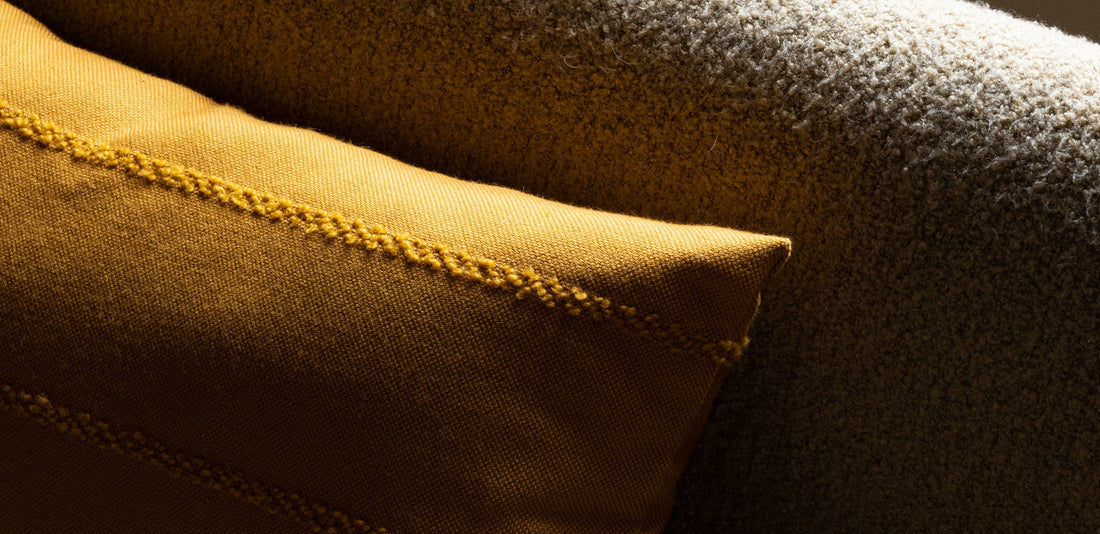Mathias Mentze, Alexander Ottenstein and Marie-Louise Rosholm share their thoughts on their collaboration on the Cocoon Textile Collection, made exclusively for AUDO.

Tell us about your practice?
Mathias Mentze: “We design interiors and furniture within an architectural context, and from an increasing awareness of and need for intimate, haptic and textural experiences. We want to revitalize the interior design field with a focus on well-being.”
Alexander Ottenstein: “I am a trained architect and for five years prior to joining Mathias in the company, I worked at two of the larger Danish architectural studios. This has made me familiar with large-scale projects, but it’s on the smaller projects, the kinds of assignments that we are doing now, that I feel my sensibilities and interests are being used to their full potential.”
Marie-Lousie Rosholm: “As a textile designer I include as much sustainable matter as possible in my work. It’s vital to instill sustainability in every task and to discuss the topic in all collaborations. I have chosen to use my professional capabilities to fight for a better world.”

How do you approach your work?
Mathias Mentze: “Our approach is curious, site-specific and quite archaeological—we focus on unfolding local history, narratives and identities through design. We see interior design as a process of layering, with respect for what is – or was – already there. We are also fascinated by traditions and evolution, and work in close dialogue with trained craftspeople who deeply understand materials.”
Alexander Ottenstein: “Mathias is really good at ideating—coming up with some obscure reference he saw in a book ten years ago. While I am more, “Okay, so if this is what we want to achieve, how do we get there?” Both approaches are important in the creative process.”
Marie-Lousie Rosholm: “I’m a trained weaver and this practical approach is one of my most important skills, for many reasons. It also allows me to talk to production specialists to achieve results closer to the original idea than would otherwise be possible. Designing is about solving challenges on many different levels.”

Which designers or creative movements have been most influential to your work?
Alexander Ottenstein: “Right now, what interests me the most is architecture and design from the Danish Arts and Crafts movement, Skønvirke, meaning ‘beautiful work.’ This era, just before Modernism, had an intense focus on craft and ornamentation but without being over-decorative.
What makes a design valuable?
Marie-Lousie Rosholm: “When is made to last aesthetically, sustainably and qualitively. That it fits the context and the economic climate it is made for. Also, when it has a purpose that is not only to make money.”

How have you collaborated on this collection? What different skills and ideas did each of you bring to the project?
Mathias Mentze: “Alex and I love the architectural qualities of textiles and we discovered so much in Marie-Louise’s extensive material archive. We spent six months examining the different ways of weaving certain fibres and discussing the personal narratives of the pieces in her collection. We then elaborated on these re-discoveries together.”
Alexander Ottenstein: “The process has been incredibly intuitive and inspiring. Mathias and I had never worked directly with textiles before, so we had long sessions with Marie-Louise at her studio, browsing her archives, working on the loom, discussing references to old Scandinavian textiles, and sharing Proustian moments where an entire holiday is recalled through the memory of a simple French bistro napkin.”
Marie-Lousie Rosholm: “It’s been a homogeneous process with common references and values, energy, enthusiasm and healthy discussions which brought new aspects to the designs. And entirely without disagreement. I contributed with the materials and Mathias and Alexander with the designs, in one collaborative flow.”
What were some of the main inspirations for the collection?
Mathias Mentze: “We were aiming to work as sustainably as possible, using locally sourced mono-materials. We also wanted to create what we felt was missing from our own lives—textiles that are exclusive yet approachable and that will last.”
Alexander Ottenstein: “We wanted to create the kinds of products that we simply have not been able to find anywhere in the world. A lot of the collection sprung from this idea of the French bistro napkin.”

How would you describe the Cocoon Collection and its materiality?
Mathias Mentze: “We chose luxurious, natural, raw materials and added small details to create an intimate sense of scale and touch. We’ve combined different textiles—such as wool and silk—to create contrast and interest and to accentuate the natural drape of each piece.”
Alexander Ottenstein: “The result is both highly technical and beautiful. We wanted to create textiles that are ornamental not through prints or patterns, but through the inherent qualities of the material. There’s something incredibly authentic about the final products. They invite to touch and closer inspection: from the orange sheen of the red linen cushion to the way in which the stripes of the Battus Throw appear just by weaving in a few threads of silk.”
Marie-Lousie Rosholm: “The pieces in the collection are classic with a twist, and they push boundaries. Materiality has been our benchmark. I proposed mono materials to sustain the circularity of the products. It’s a collection of extraordinary Italian textiles; in fact, some of the pieces are the very pinnacle of Italian textile making.”

How have you approached responsible design, sourcing and production?
Marie-Lousie Rosholm: “I wanted to use local European suppliers and focus on mono materials for a simple recycling process. By using cellulosic materials sewn with cotton thread and labels, the entire cushion – bar the metal zip – is fully recyclable. Inner cushions are made from recycled PET bottles. Both material and production process are transparent and traceable. Most of all, our focus has been on longevity in terms of design, colours and materials. Longevity is the most sustainable action we can take.”
